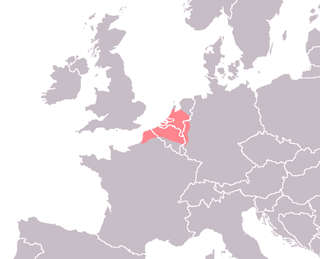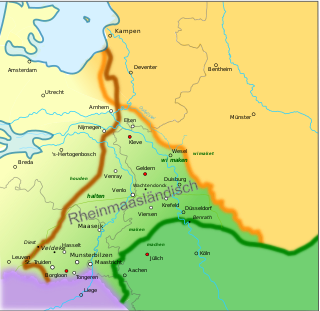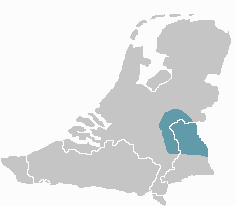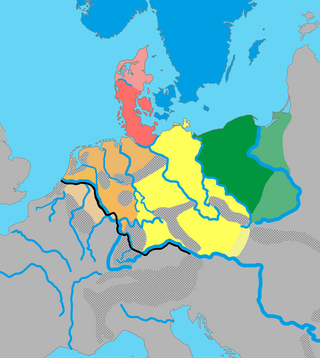
German is a West Germanic language in the Indo-European language family, mainly spoken in Western and Central Europe. It is the most widely spoken and official or co-official language in Germany, Austria, Switzerland, Liechtenstein, and the Italian province of South Tyrol. It is also an official language of Luxembourg and Belgium, as well as a recognized national language in Namibia. There further exist notable German-speaking communities in France (Alsace), the Czech Republic, Poland, Slovakia, Denmark, Romania and Hungary (Sopron).
The High German languages, or simply High German – not to be confused with Standard High German which is commonly also called "High German" – comprise the varieties of German spoken south of the Benrath and Uerdingen isoglosses in central and southern Germany, Austria, Liechtenstein, Switzerland, Luxembourg, and eastern Belgium, as well as in neighbouring portions of France, Italy, the Czech Republic (Bohemia), and Poland. They are also spoken in diasporas in Romania, Russia, Canada, the United States, Brazil, Argentina, Mexico, Chile, and Namibia.

The West Germanic languages constitute the largest of the three branches of the Germanic family of languages. The West Germanic branch is classically subdivided into three branches: Ingvaeonic, which includes English and the Frisian languages; Istvaeonic, which encompasses Dutch and its close relatives; and Irminonic, which includes German and its close relatives and variants.

Limburgish, also called Limburgan, Limburgian, or Limburgic, is a West Germanic language spoken in Dutch Limburg, Belgian Limburg, and neighbouring regions of Germany.

Ripuarian is a German dialect group, part of the West Central German language group. Together with the Moselle Franconian which includes the Luxembourgish language, Ripuarian belongs to the larger Central Franconian dialect family and also to the linguistic continuum with the Low Franconian languages.

Frankish, also known as Old Franconian or Old Frankish, was the West Germanic language spoken by the Franks from the 5th to 9th century.

Hollandic or Hollandish is the most widely spoken dialect of the Dutch language. Hollandic is among the Central Dutch dialects. Other important language varieties of spoken Low Franconian languages are Brabantian, Flemish, Zeelandic, Limburgish and Surinamese Dutch.

The Anglo-Frisian languages are the Anglic and Frisian varieties of the West Germanic languages.

German dialects are the various traditional local varieties of the German language. Though varied by region, those of the southern half of Germany beneath the Benrath line are dominated by the geographical spread of the High German consonant shift, and the dialect continuum that connects German to the neighboring varieties of Low Franconian (Dutch) and Frisian.
Dutch is a West Germanic language, that originated from the Old Frankish dialects.

Franconian or Frankish is a collective term traditionally used by linguists to refer to many West Germanic languages, some of which are spoken in what formed the historical core area of Francia during the Early Middle Ages.

In linguistics, Old Dutch or Old Low Franconian is the set of dialects that evolved from Frankish spoken in the Low Countries during the Early Middle Ages, from around the 6th or 9th to the 12th century. Old Dutch is mostly recorded on fragmentary relics, and words have been reconstructed from Middle Dutch and Old Dutch loanwords in French.

In linguistics, Meuse-Rhenish is a term with several meanings, used both in literary criticism and dialectology.

Kleverlandish is a group of Low Franconian dialects spoken on both sides of the Dutch-German border along the Meuse and Rhine rivers.

Weser–Rhine Germanic is a proposed group of prehistoric West Germanic dialects, which includes both Central German dialects and Low Franconian, the ancestor of Dutch. The term was introduced by the German linguist Friedrich Maurer as a replacement for the older term Istvaeonic, with which it is essentially synonymous. The term Rhine–Weser Germanic is sometimes preferred.
Dutch dialects are primarily the dialects that are both cognate with the Dutch language and spoken in the same language area as the Dutch standard language. They are remarkably diverse and are found within Europe mainly in the Netherlands and northern Belgium.

Dutch is a West Germanic language, spoken by about 25 million people as a first language and 5 million as a second language and is the third most spoken Germanic language. In Europe, Dutch is the native language of most of the population of the Netherlands and Flanders. In South America, it is the native language of the majority of the population of Suriname, and spoken as a second language in the polyglot Caribbean island countries of Aruba, Curaçao and Sint Maarten. All these countries have recognised Dutch as one of their official languages, and are involved in one way or another in the Dutch Language Union. Dutch Caribbean municipalities have Dutch as one of the official languages too. Up to half a million native speakers reside in the United States, Canada and Australia combined, and historical linguistic minorities on the verge of extinction remain in parts of France and Germany.

The name of the Franks, alongside the derived names of Francia and Franconia, are derived from the name given to a Germanic tribal confederation which emerged in the 3rd century AD.
Duisburg dialect is the extinct Low Franconian dialect that was spoken in the German city of Duisburg.
















